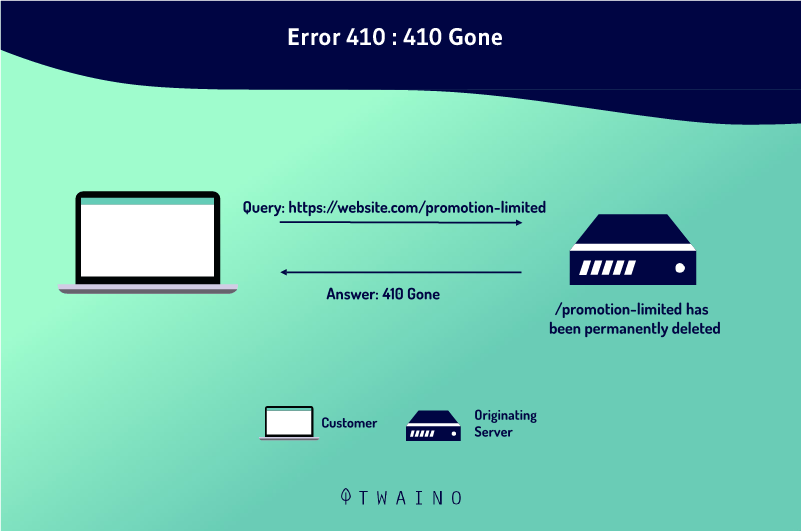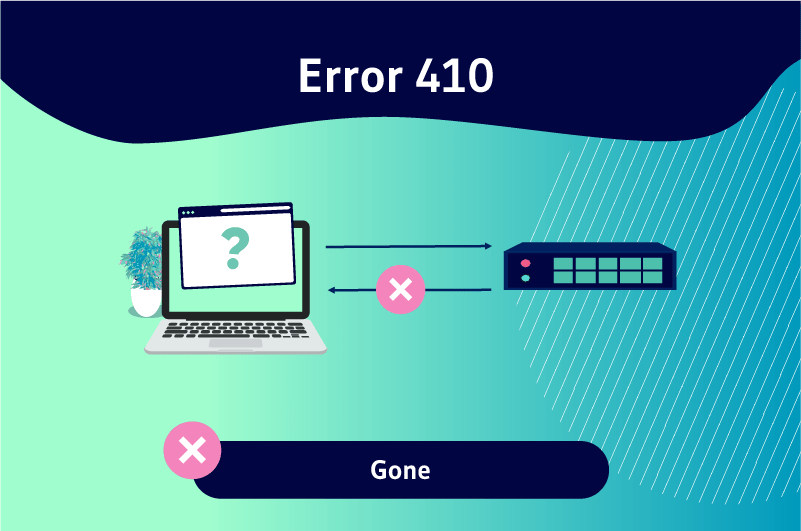Discover the mystery behind the cryptic error message 410 gone and unlock the secrets of its significance in the digital world.

Image courtesy of via DALL-E 3
Table of Contents
Introduction to ‘410 Gone’
In the vast world of the internet, websites communicate with each other and users through a special language known as an HTTP status code. One of these codes, the ‘410 Gone,’ holds a unique significance for websites and their visitors. In this section, we will explore what exactly this mysterious code means and why it plays a vital role in the realm of web browsing.
What is an HTTP Status Code?
Before diving into the specifics of ‘410 Gone,’ let’s unravel the concept of an HTTP status code. Imagine you’re sending a message to a friend, and the friend responds with different emojis like a thumbs up or a sad face. In a similar way, when you visit a website, the website’s server sends a status code to your browser to indicate how the request was handled. It’s like a digital handshake between your browser and the website’s server!
What Does ‘410 Gone’ Mean?
Now, let’s decode the mystery behind ‘410 Gone.’ When a website displays the ‘410 Gone’ status code, it’s like saying, “Sorry, the content you’re looking for used to be here, but it has been permanently removed. It’s gone for good.” Unlike a casual ‘404 Not Found’ message that simply says the content couldn’t be found at that moment, ‘410 Gone’ signifies that the content has been deliberately taken down and won’t be coming back.
Why ‘410 Gone’ is Used
When webmasters use the ‘410 Gone’ status code, it means that the content on a webpage has been permanently removed. Imagine you have a book that you no longer want to keep on your bookshelf. Instead of just moving it to a different spot, you decide to give it away, and it’s never coming back to your shelf. That’s similar to what ‘410 Gone’ signifies – the content is gone for good.
Difference from ‘404 Not Found’
Now, you might wonder how ‘410 Gone’ is different from the more commonly known ‘404 Not Found’ error. When a web page shows a ‘404 Not Found’ message, it means the server can’t find the content at that moment. It’s like looking for a toy in your room, but it’s hiding somewhere you can’t see. With ‘410 Gone,’ it’s as if the toy has been given away, and you won’t find it even if you keep searching.
By using ‘410 Gone’ instead of ‘404 Not Found,’ webmasters are clearly telling users that the content was once there but has been intentionally and permanently removed.
How ‘410 Gone’ Affects Users
When users come across a ‘410 Gone’ message while browsing the web, it can be quite frustrating. Imagine you’re trying to visit a website, but instead of seeing the information you were looking for, you are met with a message saying that the content is permanently gone. This can leave you feeling lost and disappointed, especially if you were counting on that information.

Image courtesy of www.twaino.com via Google Images
Handling Broken Links
Broken links that lead to ‘410 Gone’ pages can disrupt your web browsing experience. Typically, when users encounter a ‘410 Gone’ error, they may try refreshing the page or going back to the previous page to see if the link works again. If the issue persists, users might try searching for the content they were looking for on a different website or contact the website owner to see if the content can be restored.
How Webmasters Implement ‘410 Gone’
When webmasters want to signal that a web page has been permanently removed from a website, they can configure their servers to return a ‘410 Gone’ status code. This tells search engines and browsers that the content is gone for good, unlike temporary removal indicators like ‘404 Not Found’.
Impact on Search Engine Optimization (SEO)
Implementing ‘410 Gone’ can have a significant impact on a website’s SEO strategy. By using this status code, webmasters can ensure that search engines no longer index or rank the removed content. This can be beneficial in situations where having outdated or irrelevant pages indexed by search engines can harm the overall ranking of the website.
Popular Use Cases for ‘410 Gone’
One popular use case for the ‘410 Gone’ status code is to remove expired or outdated content from a website. When content is no longer relevant or accurate, webmasters can use ‘410 Gone’ to signal to search engines and users that the content has been permanently removed. This helps keep the website up-to-date and ensures that visitors are not misled by outdated information.

Image courtesy of www.twaino.com via Google Images
Enhancing Website Security
Another common scenario where ‘410 Gone’ is utilized is to enhance website security. By using the ‘410 Gone’ status code to remove specific pages or files that may pose a security risk, webmasters can prevent unauthorized access or exploitation of vulnerable content. This proactive approach to security helps safeguard the website and its visitors from potential threats.
Alternatives to ‘410 Gone’
When a webmaster removes content from their website but wants to indicate that it is temporarily unavailable rather than permanently gone, they may opt to use the ‘404 Not Found’ status code. This code communicates to the user that the content they are looking for is currently missing but may reappear in the future.
Redirection Methods
In some cases, webmasters may choose to employ redirection methods as an alternative to using the ‘410 Gone’ status code. One common technique is the use of a 301 redirect, which directs users and search engines to a different URL where the content now resides. This method ensures that users are seamlessly redirected to the new location of the information they are seeking.
‘410 Gone’ in Action
Imagine you are browsing your favorite website, trying to find an article you read a while back. However, when you click on the link to that article, instead of seeing the content you were looking for, a message pops up saying ‘410 Gone’. This means that the webmaster has permanently removed that particular page from the website.

Image courtesy of www.shutterstock.com via Google Images
Steps Taken by the Webmaster
The webmaster made the decision to use the ‘410 Gone’ status code to let users know that the content they were looking for is no longer available on the site. This could be due to various reasons, such as the information being outdated, irrelevant, or even posing a security risk.
By setting up ‘410 Gone’ on the server, the webmaster ensures that users who try to access the removed content are immediately informed that it has been permanently taken down. This helps in maintaining the website’s integrity and user experience by avoiding confusion or frustration among visitors.
Conclusion
In conclusion, understanding the significance of the ‘410 gone’ status code is crucial for webmasters and users alike. This HTTP status code indicates that content has been permanently removed from a website, allowing webmasters to inform search engines and users about the elimination of specific content. By utilizing ‘410 gone’ appropriately, webmasters can enhance website maintenance, security, and overall user experience.
Recap of ‘410 Gone’
Simply put, ‘410 gone’ is a specific HTTP status code that informs browsers that the requested content has been permanently removed from the website. Unlike the more common ‘404 not found’ code, ‘410 gone’ explicitly states that the content is no longer available and is not expected to return.
Key Takeaways
Key takeaways from our discussion on ‘410 gone’ include the importance of accurately signaling the permanent removal of content, the impact of this status code on user experience and website security, and the ways in which webmasters can implement ‘410 gone’ to manage their websites effectively. By grasping the essence of ‘410 gone,’ webmasters can boost their website management practices and enhance user trust and satisfaction.
Want to turn these SEO insights into real results? Seorocket is an all-in-one AI SEO solution that uses the power of AI to analyze your competition and craft high-ranking content.
Seorocket offers a suite of powerful tools, including a Keyword Researcher to find the most profitable keywords, an AI Writer to generate unique and Google-friendly content, and an Automatic Publisher to schedule and publish your content directly to your website. Plus, you’ll get real-time performance tracking so you can see exactly what’s working and make adjustments as needed.
Stop just reading about SEO – take action with Seorocket and skyrocket your search rankings today. Sign up for a free trial and see the difference Seorocket can make for your website!
Frequently Asked Questions (FAQs)
Why is ‘410 gone’ better than ‘404 not found’?
Some webmasters prefer using ‘410 gone’ instead of ‘404 not found’ because it clearly indicates that the content has been permanently removed. When a user encounters a ‘404 not found’ error, they may assume that the content is temporarily unavailable or that there is a technical issue. In contrast, ‘410 gone’ communicates to both users and search engines that the content is intentionally gone, which can help in managing website credibility and user experience.
How long does ‘410 gone’ stay in effect?
The ‘410 gone’ status code is intended to signal that the content has been permanently removed. Once a webmaster sets a page to ‘410 gone’, it should remain in effect indefinitely. However, there may be instances where a website owner decides to reinstate the content, in which case they would need to remove the ‘410 gone’ status for that specific page.
Can I change a ‘410 gone’ status back to active?
Yes, a webmaster can reverse the ‘410 gone’ status for a page if they decide to reinstate the content. To do this, the webmaster would need to update the server configuration to remove the ‘410 gone’ status and make the page accessible again. It is important to ensure that the content is relevant and up-to-date before changing the status back to active to maintain a positive user experience and SEO performance.







